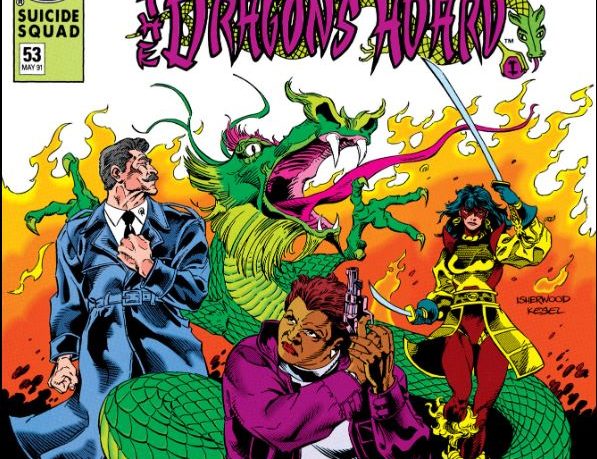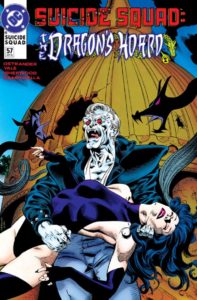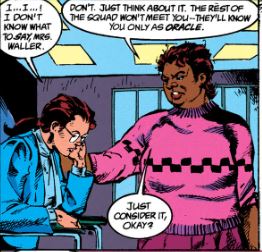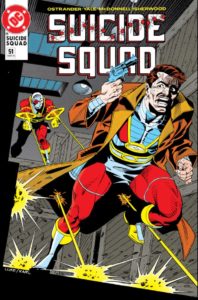
Volume Seven of Suicide Squad collects Issues #50-#58. It’s the penultimate chapter, so there are tons of fun callbacks to earlier issues. In fact, we get the return of the original Squad from Suicide Squad #1. As always, here is a link to the previous entry. Without further delay, let’s jump right in.
Family Reunion
The Squad is tasked with rescuing Rick Flag in this oversized 50th issue. No, not that Rick Flag, but rather him and Karin Grace’s secret love child who shares the same name as his father. The issue opens with a return to the Mission X iteration of the Suicide Squad, last seen in Secret Origins #14. Led by Rick Flag, Karin Grace, Jess Bright, and Dr. Hugh Evans, the latter two seemingly fall to their deaths. However, physicist Jess Bright barely survives, eventually joining The Jihad as Koshchei the Deathless and vowing revenge on Flag and Grace. Bright kidnaps their child in the hopes of luring Flag into a confrontation, not knowing that Flag has already died. Out of respect for their fallen field leader and at the behest of General Jeb Stuart, the Squad gears up to rescue Flag and Grace’s son.
 The beginning of this series doesn’t have as much supervillain deaths as one might think based on its start. There were characters who died, but Ostrander quickly establishes those that would become staples of the Squad. Nemesis, Nightshade, Bronze Tiger, and of course, Boomerang and Deadshot all make a return, and it just feels right. Even The Enchantress pops in for a moment, though severely depowered. And an even deeper cut is the return of the original “fake” airport that The Jihad first used in Suicide Squad #1.
The beginning of this series doesn’t have as much supervillain deaths as one might think based on its start. There were characters who died, but Ostrander quickly establishes those that would become staples of the Squad. Nemesis, Nightshade, Bronze Tiger, and of course, Boomerang and Deadshot all make a return, and it just feels right. Even The Enchantress pops in for a moment, though severely depowered. And an even deeper cut is the return of the original “fake” airport that The Jihad first used in Suicide Squad #1.
This issue has a lot of references that are sure to please loyal Suicide Squad readers. But it’s been quite awhile since those early issues, and it’s fun to see where the original team is at now. Characters such as Bronze Tiger, Nightshade, and Nemesis readily accepting another Squad mission despite Waller’s misdeeds speaks to the camaraderie they shared with Flag. It’s never spoken in this issue, but their willingness to save Flag’s son is a great reference to his “carry on” mantra for those who have died in battle.
Fractured Image
Suicide Squad #51 capitalizes on the recent plot thread of Deadshot’s lost luggage (no thanks to Boomerang). Missing since issue #45, Lawton’s luggage has wound up in France. But more alarmingly, someone has stolen the Deadshot getup and is ruining his reputation. Dressed as regular old Floyd Lawton, he must now retrieve his lost luggage and punish the person responsible for tarnishing his name.
Floyd Lawton has evolved quite a bit since Suicide Squad #1. He’s a traditional man’s man, smoking a pack a day and shooting before asking questions first. He takes everything to the logical extreme. Need him to stop Rick Flag from killing the senator? Ok, Lawton will kill the senator himself. Not exactly what you were asking for? Should’ve been more clear. All this still holds true for the character as the series nears its end, but it is much more subdued. Starting with the events of his first miniseries, killing Senator Cray in Suicide Squad #22, and then his subsequent imprisonment in Arkham, Floyd has quietly gone through a bit of an identity crisis. It becomes clear something inside of him has irrevocably broken, and like a lot of men who present a tough exterior, their emotions lash out in violent outbursts.
In the end, Lawton emphatically kills the Deadshot imposter—the guy never really stood a chance. And as the morning sun rises, cigarette in hand, Floyd Lawton walks away without his luggage. Or, perhaps, without the extra baggage. The imposter wins. He gets to keep the Deadshot suit. Not exactly the way he wanted to, but, hey, he should’ve been more clear.
The Return of Dr. Light
The Squad has had its fair share of joke supervillains, but none have been more pathetically hilarious than Arthur Light. Last seen in issue #36, Suicide Squad #52 revisits Hell where both Dr. Lights continue to bicker in front of the Devil and his annoyingly eager demon servant. Well, not the Devil but a Devil who goes by the name Mister Biff. Unamused and eternally agitated, Mister Biff grants both Dr. Lights a second chance at life, but with an unfair twist because, as Mister Biff himself puts it, “Of course it’s unfair, you nitwit! This is Hell!”
The concept of a Hell where everyone is doomed to spend eternity with the people that annoy them the most is revisited in this issue. What follows is a slapstick, Looney Tunes-style filler story. Guest artist Jim Fern’s stretchy and disproportionate art is jarring compared to the rest of the art in this series, but it’s fitting for such a wacky premise. And though the humor is unusually frenetic and feverish, it still has Ostrander’s signature dry humor stamped all over it. Lastly, we’re introduced to a third Dr. Light named Kimiyo Hoshi. She is completely unrelated to the other two Dr. Lights, but the fact that she gets sucked into their odd predicament just adds to the absurdity. Or maybe it’s a cautionary tale: Whether superhero or supervillain, stay away from the name Dr. Light!
The Dragon’s Hoard

In this five part story arc, there is a cache of hidden Soviet weapons in Cambodia that is going to be sold to the Yakuza in Japan. Intent on preventing further bloodshed on the streets of Tokyo, Japanese businessman, Mr. Fujiwara, hires the Squad to neutralize the weapons before it can be sold. It’s a simple premise, but this is the Suicide Squad and nothing is ever as simple as it seems.
The Dragon’s Hoard succeeds by giving each character something meaningful to do. Tightly scripted, four to five issue story arcs are a staple of this run, and longtime fans will find that familiarity here. Each page and character decision in The Dragon’s Hoard feels impactful, and keeps the reader engaged at all times. And whether the team succeeds or not isn’t as important as the effect the mission has on its members. Specifically, The Dragon’s Hoard teases the idea that Oracle may replace Waller as the new leader of the Suicide Squad. I don’t think this idea ever comes to fruition considering Oracle becomes a prominent member of the Birds of Prey. However, it’s an interesting “What if?” moment for a character that was saved from obscurity by Ostrander and Yale.
 Nearing the end of Ostrander’s Suicide Squad run, we’re beginning to witness the passage of time. One such instance is with Stalnoivolk, the Soviet super-soldier. An intimidating presence since The Doom Patrol and Suicide Squad Special, the gray-haired Steel Wolf is now a begrudging Squad member. A hardliner and staunch supporter of Stalin, Stalnoivolk’s growing insignificance coincides with the dissolution of the Soviet Union in 1991, the same time this issue was published. The Steel Wolf was a scientific marvel when he was first created, a true Soviet Superman. But that was ages ago, and as Waller states, “We got things called lasers.” This harkens back to the conversation between Waller and Batman in Suicide Squad #43. History is happening at a breakneck pace, and the ability to adapt and change with the times is more important than ever.
Nearing the end of Ostrander’s Suicide Squad run, we’re beginning to witness the passage of time. One such instance is with Stalnoivolk, the Soviet super-soldier. An intimidating presence since The Doom Patrol and Suicide Squad Special, the gray-haired Steel Wolf is now a begrudging Squad member. A hardliner and staunch supporter of Stalin, Stalnoivolk’s growing insignificance coincides with the dissolution of the Soviet Union in 1991, the same time this issue was published. The Steel Wolf was a scientific marvel when he was first created, a true Soviet Superman. But that was ages ago, and as Waller states, “We got things called lasers.” This harkens back to the conversation between Waller and Batman in Suicide Squad #43. History is happening at a breakneck pace, and the ability to adapt and change with the times is more important than ever.
War of the Gods
Suicide Squad #58 is a tie-in issue to a larger crossover event, and it’s an awkward bookend to this volume. And like any superhero crossover event, there’s a plethora of irrelevant characters who show up. It’s also funny how Black Adam insists the Squad dress up in their “ceremonial garb,” A.K.A. costumes. This is presumably because a crossover requires characters to wear their colorful costumes. This is despite the Squad’s recent shift towards lowkey, street-level espionage missions. There is one significant development which is Vixen leaving the Squad and, subsequently, ending her relationship with Bronze Tiger. It’s a personal and quiet moment for a couple whose relationship is broken by the Suicide Squad.
I should also mention that there is a hilarious parody of Grant Morrison who shows up here. Going by the name “The Writer,” he has the metanarrative power to write things into reality using his typewriter. This includes “fwoomps” and other comicbook sound effects. And his kryptonite? Writer’s block, a hesitation that gets him killed in the battlefield. To his credit, Ostrander admits to being a bit too snarky for even his own sensibilities and regrets unceremoniously killing off Morrison’s character. In any case, it’s a rather harmless gag and makes this issue worth talking about. Next issue teases the development of the team’s most recent member, Adam Cray, the new Atom, and he’s got a bone to pick with Deadshot.
Check back here next month to see the Squad take on their most suicidal mission yet: An angry Justice League! It’s the final mission and the gloves are off, so don’t miss it!






